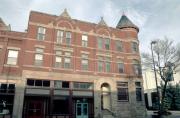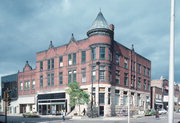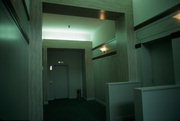| Additional Information: | A 'site file' exists for this property. It contains additional information such as correspondence, newspaper clippings, or historical information. It is a public record and may be viewed in person at the Wisconsin Historical Society, State Historic Preservation Office.
The Barnes Block is a three story commercial structure that dominates a main intersection in Eau Claire's central business district. The imposing building is faced with rusticated stone block at the first level and with a muted red brick at the second and third levels. This combination of building materials and certain key stylistic features links the building with Richardsonian Romanesque architectural design of the late 19th century. Features that particularly distinguish the building include the round corner tower with a conical slate roof, and the round-arched entrance to the upper stories on the west side. The simple cornice is accentuated by three gablets, trimmed with rusticated stone finials and stone arches. Narrow, two story molded brick piers frame the three gabled units. Rusticated stone sills, lintels, and courses highlight the fenestration, largely composed of double-hung sash.
The exterior of the building is largely intact. Inside, the first floor has been substantially altered.
The neighboring building, 15 S. Barstow Street, 1P/21, is also considered part of the Barnes Block and is included in the nomination (A). Immediately to the north of the Barnes Block is a smaller two story brick and rusticated stone commercial building that is considered part of the Barnes Block despite the difference in size. The two buildings share a party wall, and there is access between the buildings at the second floor. This building was allegedly designed by the same architect and built by the same contractor. A brick gablet and overlighted windows with stone sills and lintels link the building stylistically to the main block, as do the construction materials, However, the decorative brick friezes on the two story structure are more elaborate, dominating the rusticated trim. The ground story storefront has been largely modified, but the second story is intact. The contiguous building to the north formerly matched this structure, but alterations have totally obscured the facade.
The Barnes Block is the best surviving example of grand-scale commercial design in the Richardsonian Romanesque mode in the city of Eau Claire. The prominent corner location of the former Chippewa Valley Bank is typical of its kind in other American cities and towns, and logically with successful bankers, B.A. Buffington, H.C. Putnam, and Thomas Frawley, who organized the bank. Buffington, who began his business career as a grocer and logger, rose to become treasurer of the bank, University of Wisconsin Regent, and served in the Wisconsin General Assembly from 1897 to 1901. Putnam, who settled in Eau Claire in 1857, was also a surveyor and Register of Deeds; he is recognized as a leading figure in the commercial history of the city. Thomas F. Frawley was admitted to the bar in 1880, and was a member of the Democratic Convention in 1892, permanent chairman of the State Democratic Convention from 1896 until his death in 1902, President of Eau Claire's Commercial Council, and a member of the Board of Education.
The crisp lines and textures of the contrasting stone rustication and the tight organization of elements distinguish the building as a piece of design. The added boon of the smaller complementary building next door testifies to the versatility of the architect and of the style (A).
RESTORED 1981.
Also listed on the National Register as a part of the Confluence Commercial Historic District, #07001047, listed on 10/3/2007 (listed on the state register 1/19/2007).
2016- "This structure features massive rough stonework at the basement and first floor levels and red brick on the upper two floors. Typical of this type of Victorian architecture are the round tower and decorative brickwork. This is the largest building in the city remaining from this architectural period.
The most prominent commercial tenant was the Chippewa Valley Bank, established by Byron Buffington, H.C. Putnam, T.F. Frawley and A.H. Holen. Another important tenatnt was Samuelson's Department Store."
-"Eau Claire Landmarks: Designated Historic Properties in Eau Claire, Wisconsin", Eau Claire Landmarks Commission, P.O. Box 5148, 2016. |
|---|





